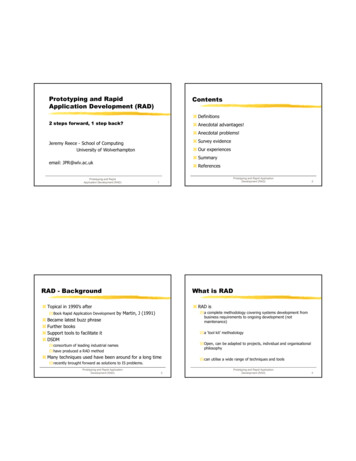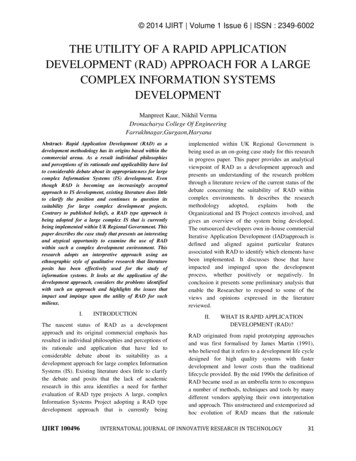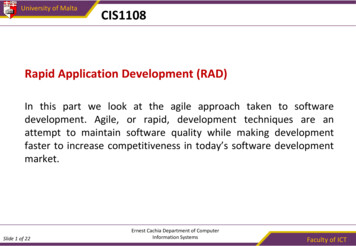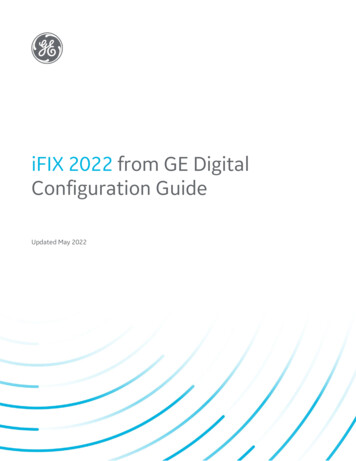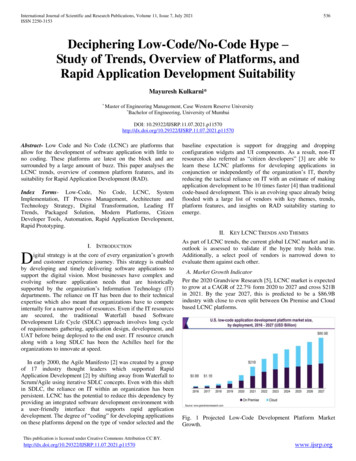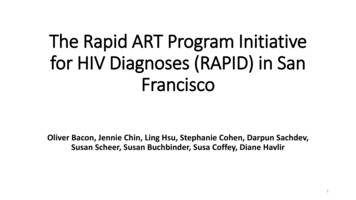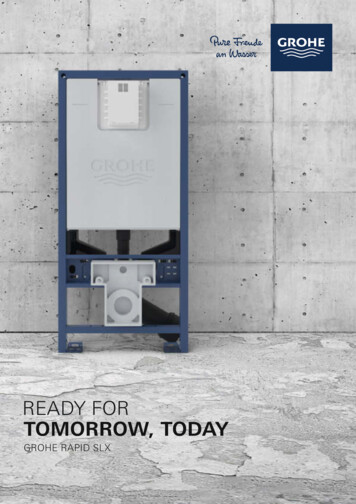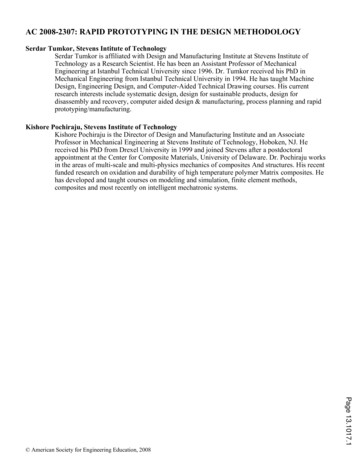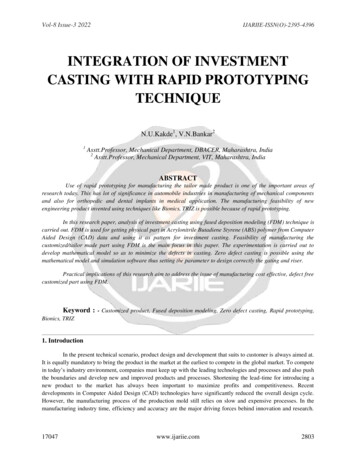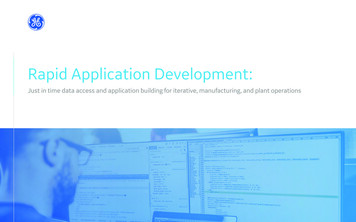
Transcription
Rapid Application Development:Just in time data access and application building for iterative, manufacturing, and plant operations
What is RAD?A new approach, referred to as Rapid ApplicationDevelopment (RAD) is no longer just a desire, it is mandatoryway of overcoming these hidden expenses.Manufacturing has changed.Manufacturers have always wanted to increase productivityand remain competitive. However, important changes to howyou do that have occurred. The industrial world has evolvedsignificantly and the single purpose operation that made thesame product over and over again for years is shifting.The demand for customization and short runs requires justin time manufacturing that can reconfigure equipment,processes and maintenance procedures with great agility.While this demand started years ago, thin margins are puttingurgent pressure on manufacturers to increase their focus onbuilding agility into their operations.Rapid Application Development is the quick developmentof customized solutions and efficient human-computerinterfaces (HMI) applied to the automation space throughtighter integration with SCADAs and GE Digital products.RAD is used to provide easier and better connectivity,configuration & build tools, deployment & security. This leadsto an overall improvement in operational agility. Visualizationand data integration capabilities are the foundation formaking this a reality. The result is more consistent visibilityacross all different types of users and personas. It’s so logical,it sounds easy, but it’s not.The modern demand for more agile manufacturing brings withit hidden costs to the business — including overtime fees, undertrained staff, documentation needs and even custom scripting.The costs can add up quickly both in terms of time & resources.Consolidating data across different levels of theorganization to achieve RAD in a secure manner ischallenging due to the time series nature of the data thatis collected and utilized for analysis. We have to collectVisibleCostsHiddenCostsProject ManagementSpecificationsProduct ComplexityBudget CutBug FixingDocumentationUnexpected Spec ChangesOvertimeBilled HoursLack of TrainingDocumentationmassive amounts of information, but also make it possibleto act quickly when circumstances demand.Overcoming this challenge is worthwhile because the benefitsare significant both in terms of shrinking time to value, butalso in reducing total cost of ownership. In fact, engineers canexperience up to a 40%* faster build/ deploy time.This happens because: A structured asset model mapped to SCADA databasespeeds up configuration time Smart objects & predefined templates allow for efficientHMI out of the box Modern technology including Docker, HTML 5, OPC UA,MQTT allows for simplified connectivity & centralizeddevelopment & deployment* GE customer interviews, based on Web HMI application experienceHardwareSoftware LicensesCustom ScriptsCustom Code / ScriptingCustom ScriptsUnexpected Spec ChangesUnplanned On-Site SupportUnbilled HoursTestsChange of ScheduleEven More Custom Code
GE Digital’s RAD Vision:Faster time to value, lowertotal cost of ownershipAt GE Digital we take our responsibility to help your organizestep progressively towards more agile operations veryseriously. For the most progressive that journey is well underway, and for others it’s just beginning. We’re proud to beleading the charge by building the technology, processes andexpertise needed to create the manufacturing operations ofthe future by bringing together disparate data sources andmultiple software tools into a centralized hub.Our goal is to help all plant users go beyond traditionalHMI/SCADA activities and improve user experiences byproviding access to data enabling customers to leveragethat data in new and significant ways.We’re not going to do this alone. We believe that an openecosystem not only honors the needs of today’s multi-vendorinvestments but provides the most flexibility for the futureacross all four critical capabilities users running and managingthe plant have to master. Connectivity, configuration,deployment and security.
Connectivity:Connecting informationacross the enterpriseConnectivity across the enterpriseis both essential and complex. Youneed to go beyond notifications andmonitoring systems. Share data viacentralized computing systems foranalysis to maximize value from allthe data that can now be collected.Our goal is to provide common tools for a single applicationacross all four levels of operational maturity:1. Intelligent equipment – sensors, gateways, controllers2. Supervisory and Control Systems – human-machineinterfaces optimized for alerts and action3. Manufacturing Operations Management – local orremote data centers consolidating plant level information4. Business Systems – data centers consolidatinginformation from across plants for a holistic view andoperation of the businessThis model ensures that you don't have to know what you need in advanced.Instead, you can maximize connections across devices, users, and locations asneeded by the operation
Configuration: datamodeling and tagmanagementEvery application and user have uniqueneeds for their role.However, you don’t have to configure a new applicationor data structure for each function. Data modelingreduces rework by shortening cycle times and allowingwork to be duplicated or reused.For example, the ISA 95 standards can be used toprovide guidance for the engineers who want tocreate an equipment model. The model helps breakthe physical world into more manageable pieces bydefining levels. It starts at the Enterprise level, thenthe Site, Area, Process Cell, Unit, Equipment Module &Control Module levels (see image). There is great valueto structure data coming from a plant with complexinfrastructure or a manufacturing facility. Throughauthorization and visibility rights the model can becollapsed and adjusted to the user’s need. i.e. defineonly the number of levels required for that specificuser’s application.The OPC UA communication protocol supports thisstructured approach. The latest instance of the OPCFoundation, unlike its predecessors, comes with aninformation model, which makes it a true interoperabilitystandard for the Industrial Internet.In the context of a RAD implementation, the automationsystem will be able to map the model defined at theasset / unit level using OPC UA and aggregate the data ina common model that can later be used as the basis toautomatically generate HMI mimics and the navigation incontext for the Operators.
In addition to data modeling, data visualization makes iteasy for an operator to set user permissions and make dataconnections within the confines of their role.Let's consider a simple example - access toequipment logs used for troubleshooting.Your equipment operator in one plant only wants to seealerts for problems on the equipment they are responsiblefor, but you have many operators with similar roles acrosslocations. In this case you might set up a threshold alert.But instead of writing code for each operator, you insteadmatch the equipment to the operator and write code thatapplies to all people with that role. That’s pretty straightforward. What if access to the logs of equipment in otherplants could help the operator locally address a problem?With the right data model, the equipment could recognizeothers who had the same problem, and proactivelycommunicate the known resolution.Although this is a simple example, it demonstrates thepower of data modeling and simplified tag management.
Deployment: Technologies andstandards that enable RADA critical part of the RAD foundation is the ability to quickly build targeted apps for an immediate need anddeploy those apps and the contained visualization as needed. Several technology advances; MQTT, HTML5,Cloud, ISA 101, ISA 18.2, make it far more efficient than in the past. MQTT is about IIoT connectivity. MQTT and OPC UA deliver connectivity (and security as far as OPC UA). HTML5 is a widely used software standard stack, when combined with responsive design tools, it allows thescreens to be available from a large number of devices: from desktops running a compatible web browser,to smartphones and tablets, including some low footprint devices used in plants like dedicated operatordisplays. ISA 101 & 18.2 are two ISA standards. ISA 101 is set of recommendations for the design of HMIs. Ourvisualization objects are based on these recommendations. ISA 18.2 is dedicated to alarm management.Some of the features of our HMI/SCADA follow the ISA 18.2 recommendations.Using these technologies to create templates that are optimal for user interaction shortens development cyclessignificantly and reduces the burden on hard to find IT resources.
Security: Usingstandards to drivesecure connectionsSecurity is an essential element for allRAD implementations.Let’s look at smart home devices as a model for ourenterprises. Consider a smart hub device like Google Homeor Amazon Echo. Consumers connect multiple applicationsto those devices and use them for central control. Perhapsthey have a doorbell with a camera in it, and lights that arecontrolled by the hub. Maybe even temperature controlthrough a smart thermostat. In order for the smart hub towork it has to recognize the device and integrate it withthe application to control the camera on the doorbell, thetemperature on the thermostat or the light bulb in the lamp.You want the hub to collect and share information, so itmust recognize those devices, and it can visualize the lampfor example in the hub interface. However, you don’t wantjust anyone turning on the lights.Our industrial operations operate in a similar context.We want data to flow in real-time across the operation, butwe need to limit the actions that can be taken with thatdata to relevant, authorized applications & employees.Interoperability through the industry standard OPC UA isthe key to provide secure agility. With OPC UA the systemitself can easily discover OPC UA compliant equipment,configure it and ensure it is securely managed.Better engineering andoperations outcomesWhen deployed correctly, using RAD will deliver fastertime to value and lower total cost of ownership acrossthe operation because auto generation & self-assembly,modeling and code free design significantly reduce build,deploy and connectivity times and costs. Best of all, RADreduces maintenance costs by reducing the amount oftime needed to maintain applications and HMIs. One ofthe biggest contributors is the ability to build responsivedesign interfaces that allow information to be consumedacross any device — smart phone, tablet, PC, or display,with a single code base. This approach ensures anyonewho needs to access information on-site or remotely caneasily do so without requiring a new interface. Lastly, digitaltools natively improve compliance with standard operatingprocedures because notifications, workflow and alerts arebuilt into the system and can’t be overwritten.When you have a centralized application, everyone has asingle source of truth and better collaboration across functionsbecomes a natural part of the organization’s workflow.Faster response for operators,faster development for engineers40358040Less timenavigatingFasteridentifyingcritical data%Fasterdevelopment%%Improvement inalarm resolution%
Operations Hub: Iterative development madepractical. Enabling optimizations through thelearnings of all on the plant floorOperations Hub was designed specifically to serve the needs of anopen ecosystem, making interfaces more intelligent, and connectingheterogeneous data sources to improve performance, improvecollaboration, find optimizations through data analysis and reducehuman error.Systems integrators and in-house engineering teams can leveragepowerful, code-free development tools to quickly assemble Web-basedapplications, enabling connectivity with GE Digital software and commonIIoT sources, such as databases and control systems, and delivering highperformance displays for the operator.The code-free tools allow multiple, non-developer users to simultaneouslycontribute to creating custom displays, which reduce costs and speeddevelopment. This substantially decreases time to create a view tomonitor abnormal situations by putting the build tools in the hand of all.Also, Operations Hub makes more information available to more usersby providing easy access to both IT and OT data sources in a contextualformat. This enables everyone in the plant to do richer analysis across agreater set of contextual information driving more informed decisions andimproved operational efficiency.Operations Hub delivers a foundation for insights into operations andproductivity, a critical step in the journey towards successful digitaltransformation of one’s organization.FIND OUT MORE
About GEGE (NYSE: GE) is the world’s Digital Industrial Company, transforming industry with software-defined machinesand solutions that are connected, responsive and predictive. GE is organized around a global exchange ofknowledge, the “GE Store,” through which each business shares and accesses the same technology, markets,structure and intellect. Each invention further fuels innovation and application across our industrial sectors.With people, services, technology and scale, GE delivers better outcomes for customers by speaking thelanguage of industry.Contact InformationAmericas: 1-855-YOUR1GE (1-855-968-7143)gedigital@ge.comwww.ge.com/digital 2019 General Electric. All rights reserved. *Trademark of General Electric. All other brands or names are property of their respective holders.Specifications are subject to change without notice. 11 2019
A new approach, referred to as Rapid Application Development (RAD) is no longer just a desire, it is mandatory way of overcoming these hidden expenses. Rapid Application Development is the quick development of customized solutions and efficient human-computer interfaces (HMI) applied to the automation space through
